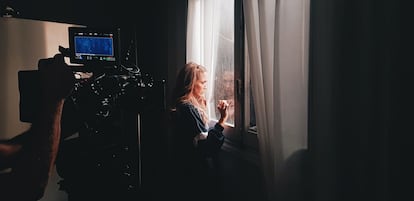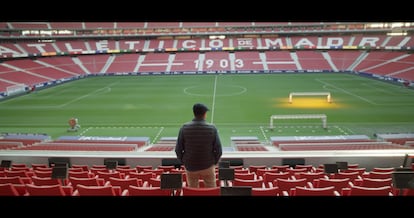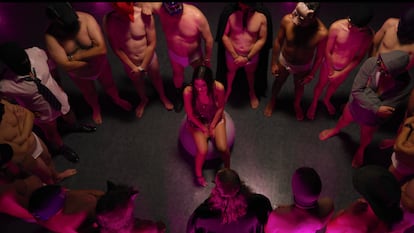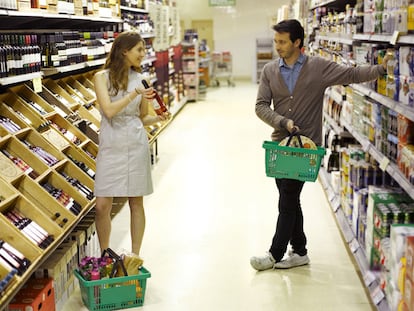The exploitation that feeds porn: ‘I was about to vomit several times. Nobody paid me any attention’
The miniseries ‘pornoXplotación,’ by Mabel Lozano, examines the industry, the trafficking networks that sustain it and its migration to the digital world
In the Eastern European country where she was born, Halyna was offered €6,000 to perform in a porn video that would be shot in Spain. She had just turned 18 and agreed to being filmed drinking the semen of two men from a glass.
Halyna’s home life was not great. Her father had walked out on the family, her mother was drowning in debt, and two of her three brothers were drug addicts: so she said yes.
When she landed in Madrid, Halyna was told there were no hotel rooms available on account of a congress and she was taken to a room in an apartment where she was met with a “Good evening and welcome, Halyna.” But that’s where the niceties ended. “The door to my room remained like my stomach, locked and padlocked,” she says, recalling that first night in Madrid. A few hours later, when the sun came up, she knew something was very wrong; that she wasn’t there to shoot the video of her drinking semen from a glass and she would be in Madrid somewhat longer than expected.
While she was having her make-up and hair done, a woman she would come to know well appeared and said, “Come on, let’s start the bukkake.” When Halyna entered the room where the filming was to take place, she saw 50 me in their underwear, their faces hidden by grotesque masks and balaclavas. She walked to the chair in the middle of the room. Then the woman said, “Don’t do anything stupid. Suck and swallow. Don’t waste my time.” The men crowded around her. “I was about to vomit several times,” says Halyna. “I made gestures with my hands for it to stop while they were shoving their penises all the way down my throat. Nobody paid me any attention. I felt like I was going to lose consciousness. The guys started to come one by one and the camera came closer to record it all.”
The person telling Halyna’s story is an actress. She tells it, as Halyna might, with her makeup smeared and her eyes brimming with tears. Halyna does not appear on the screen herself out of fear; fear that something will happen to her or to her family. Because the woman giving the orders and doing the filming is intimidating. “She threatens to hurt my mother, who is alone and in debt, and my drug-addicted brothers,” says Halyna. “She knows everything about me.”
Threats, fear, extortion and coercion run through the documentary miniseries pornoXplotación, which premiered on October 28 at the Seminci Valladolid International Film Festival. Split into three episodes, it takes the audience on a journey through the industry behind the porn, the networks of trafficking and sexual and labor exploitation that sustain it, as told by two pornographers – who show their faces –, and its migration to the digital world.

“Is it hard to hear that? Is the documentary hard to watch? No, what is hard is the reality,” director Mabel Lozano tells EL PAÍS. First it was a book, published in 2020. Lozano wrote it with Pablo J. Conellie, a police officer, specialized in trafficking and exploitation. Conellie appears in the docuseries, a collection of true stories of women tricked into moving to Spain, of minors extorted through social networks, and porn actors who relate the risks and lack of security and health precautions in the porn industry.
Their stories combine with the analysis of Lluís Ballester, doctor in Sociology and expert in youth and pornography; sociologist Beatriz Ranea; and Elena Colás, a lieutenant in the Civil Guard investigating human trafficking, who states, “Any girl can become a victim of trafficking.”
It happened to Laura. Her story went something like this: girl meets boy, boy showers girl with gifts and takes her out to dinner and dancing; girl tells him about her miserable homelife, with no father and an almost always empty fridge. He puts her in contact with a “friend” so she can get a job as a waitress and she ends up locked in an apartment, drugged, raped and sexually exploited on a daily basis to generate digital content. This also happened to Paula, Pablo’s daughter. Pablo is sitting in a soccer stadium one day when he receives a call from his wife to tell him that there is a video of his daughter, a minor at the time, spreading “like wildfire on the internet.”

Ranea describes Laura’s case as one of facilitation and abduction by someone in her environment while Paula’s case involved grooming and online sexual blackmail, perpetrated by adults against minors: a single photo can allow extortionists to continue to press children and adolescents into handing over more sexual material to be uploaded on the internet – minors who often believe that they will be able to “manage” the situation on their own, as Paula did.
More than 725,000 complaints of online sexual abuse
“The Public Prosecutor’s Report reflects how the European Union has become the largest center for child pornography related activity in the world,” Lluís Ballester tells EL PAÍS. Online sexual abuse complaints have gone from 23,000 in 2010 to more than 725,000 in 2019. “There is also data on how many men are convicted each year for using minors for pornographic purposes,” Ballester adds; 378 in 2019; and 548 for the production, possession or distribution of such material.
The Public Prosecutor’s Report also states: “Online crimes against sexual freedom and in particular those affecting minors deserve separate consideration due to their seriousness and worrying evolution. The total number of proceedings for acts of this nature committed in the digital environment amounts to 1,438, an increase of 18.45% over the 1,214 recorded in 2019.” Regarding grooming, there has been “a clear increase of more than 55% since the 225 procedures recorded in 2019, and an increase of almost 175% compared to the 127 of 2018.”
The goal: to create pornographic content for an industry that, as the series points out, generates around “€97 billion a year,” and which has been revolutionized in recent decades, moving from magazines to television to computer screens, then to the possibility of downloads and finally to the cell phone that has become a miniature mobile porn cinema with 24-hour access to clips, photos, videos and live connections. To satisfy the beast, we need “new girls, fresh meat,” as one actress explains. On the other side of the screen, “kids consume this as simple entertainment, with no idea of what’s behind it” says Lozano. Sometimes compulsively, adds Dani, who appears as a consumer of porn in the documentary: “It became a necessity,” he says. One that interfered with his life.

The young people consuming porn are getting younger. “Between the ages of 14 and 20, 25% have consumed more than 1,000 hours of porn, and 12.9% of 12- to 18-year-olds watch more than 90 minutes of porn after midnight,” says Ballester. The starting age is now eight. “It is so dangerous, and one of the reasons it happens is search engines respond with porn to any search linked to sexual curiosity. Any question about sex and the internet throws up porn, with no filters. Now porn is colonizing the other two Internet underworlds for children and adolescents – social networks and video games,” Ballester adds. “We have dragged our feet on education linked to relationships and sex. Now our capacity to mitigate the impact of these film companies is negligible.”
In the documentary, Paula’s father, Pablo, wonders if he could have done anything to prevent what happened to his daughter. Ballester, who also works with the Youth and Inclusion Network, says that’s where “the five Ps” come in: Prevention – communication within the family and parental controls; protection – once it happens, give support; participation – generating social debate and talking openly about the reality of pornography; persecution – actually “the non-persecution, because it has been proven that punishment does not work while the democratic and mature relationship generates preventive effects;” and promotion – of sexual relations that are “as pleasant and as healthy as possible.”
Tu suscripción se está usando en otro dispositivo
¿Quieres añadir otro usuario a tu suscripción?
Si continúas leyendo en este dispositivo, no se podrá leer en el otro.
FlechaTu suscripción se está usando en otro dispositivo y solo puedes acceder a EL PAÍS desde un dispositivo a la vez.
Si quieres compartir tu cuenta, cambia tu suscripción a la modalidad Premium, así podrás añadir otro usuario. Cada uno accederá con su propia cuenta de email, lo que os permitirá personalizar vuestra experiencia en EL PAÍS.
¿Tienes una suscripción de empresa? Accede aquí para contratar más cuentas.
En el caso de no saber quién está usando tu cuenta, te recomendamos cambiar tu contraseña aquí.
Si decides continuar compartiendo tu cuenta, este mensaje se mostrará en tu dispositivo y en el de la otra persona que está usando tu cuenta de forma indefinida, afectando a tu experiencia de lectura. Puedes consultar aquí los términos y condiciones de la suscripción digital.
More information
Últimas noticias
Most viewed
- Sinaloa Cartel war is taking its toll on Los Chapitos
- Oona Chaplin: ‘I told James Cameron that I was living in a treehouse and starting a permaculture project with a friend’
- Reinhard Genzel, Nobel laureate in physics: ‘One-minute videos will never give you the truth’
- Why the price of coffee has skyrocketed: from Brazilian plantations to specialty coffee houses
- Silver prices are going crazy: This is what’s fueling the rally












































